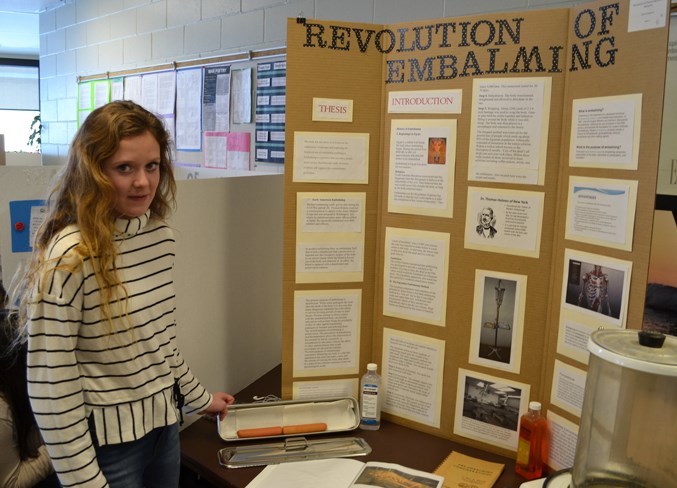OLDS - A Grade 7 École Deer Meadow School student has been named second runner-up and received a silver medal for an unusual science project – Revolutions of Embalming. It’s a look at the history and art of embalming.
Kiara Longmuir’s project was one of many displayed during the Mountainview Science and Technology Society’s annual science fair, held at Olds High School last month on March 3.
Her project qualified to compete in the Central Alberta Regional Science Fair later last month.
Longmuir told Mountian View Publishing she created the project because “a lot of people don’t really know about the topic and don’t really know what happens after you die. So I thought that I could learn about it to inform other people.”
She said she also has an interest in becoming a doctor.
Longmuir relayed what she’d learned as a result of researching the topic.
“When embalming first started it was with the Egyptians and what they did they embalmed for two reasons,” she said.
“One was religious beliefs. They believed if the body was intact then they could reincarnate and the soul would come back to the body. The second reason was for health reasons. They believed it was more sanitary to be mummified.”
She explained in rather grisly detail how Egyptians cleaned the body and injected various ingredients to preserve it, then dehydrated it so it would be preserved for a longer period.
The mummies would then be wrapped in 1,200 yards of cloth, put in a coffin and given back to the family, she said.
Longmuir’s display not only highlighted the history of embalming, it also featured a container with two wieners. One had been embalmed and one hadn’t.
“This one has a pink look because it was injected with pink formaldehyde that they use to have a more lifelike appearance,” she said. “And this one’s just a normal hotdog.
“This one’s a lot firmer than this one,” she said, pointing to the pink wiener.
The idea was also to see if bacteria would remain on the wiener that had been injected.
Longmuir’s display contained pictures of various embalming tools as well as photos of people who had advanced the practice over the centuries.
“These are just some of the different chemicals that are used for doing this,” she said. “There’s different colours of them because they represent the flesh-like appearance of the body.
“So what they do is they insert that into the femoral arteries (large veins in the thighs) and the jugular veins.
“They insert those into them and then this machine takes out all the blood and then as they insert these into them it gives them a more lifelike look for viewing for the family.”
Meanwhile, six Chinook’s Edge students from Innisfail and Olds high schools – Team Central Alberta - are heading to the Canada-Wide Science Fair at Ottawa’s Carleton University May 12-19.
They were selected after their projects were judged last month at the Central Alberta Rotary Science Fair at Red Deer College.
The six students from grades 7 to 12 that are going to the nation’s capital are Innisfail High School’s Ben Jud and Kirk Rieberger, and from Olds High School are Nicole Green (her sixth national fair), Correne Minty, Claire Petersen and Emily Martinez.



